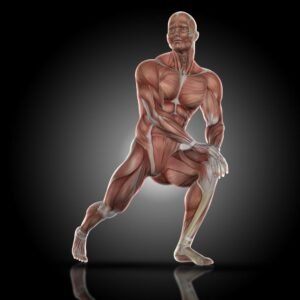CBD for Hip Pain: Improving Mobility and Comfort with 10 FAQs
Understanding CBD: What Is It and How Does It Work? CBD for hip pain, commonly known as CBD, is a phytocannabinoid derived from…
Understanding CBD: What Is It and How Does It Work?
CBD for hip pain, commonly known as CBD, is a phytocannabinoid derived from the cannabis plant. Unlike its more famous counterpart, tetrahydrocannabinol (THC), CBD does not produce the psychoactive effects typically associated with marijuana use. This distinction is crucial for individuals seeking the therapeutic benefits of cannabis without the intoxicating effects. CBD has garnered significant attention in recent years, particularly for its potential health benefits, including relief from pain, anxiety, and inflammation.
The endocannabinoid system (ECS) plays a significant role in how CBD for hip pain interacts with the body. The ECS consists of a network of receptors, endogenous cannabinoids, and enzymes that help regulate various physiological processes such as mood, appetite, and pain sensation. CBD primarily interacts with two main receptors in the ECS: CB1 and CB2. While CB1 receptors are mainly located in the brain and central nervous system and are responsible for managing pain perception, CB2 receptors are predominantly found in the immune system and peripheral tissues, including joints.
When CBD is consumed, it binds to these receptors, which may lead to the modulation of pain pathways and reduction of inflammation. This interaction has shown promise in alleviating various types of pain, including hip pain caused by conditions such as arthritis or injuries. Numerous studies suggest that CBD’s anti-inflammatory properties can help alleviate discomfort, enhance mobility, and improve the overall quality of life for those suffering from hip pain and related ailments. Additionally, using CBD for hip pain may complement other pain management strategies, providing a holistic approach to treatment.
As the research on CBD progresses, it is essential to approach its use with an understanding of personal health needs and consult with healthcare professionals. In summary, CBD for hip pain offers a natural alternative for individuals seeking relief from hip pain, leveraging its unique interaction with the body’s endocannabinoid system to promote comfort and mobility.
The Science Behind CBD for Hip Pain Relief
Recent scientific studies have increasingly highlighted the potential of CBD for hip pain relief, particularly due to its anti-inflammatory and analgesic properties. Cannabidiol (CBD), a non-psychoactive compound derived from the cannabis plant, has garnered attention for its ability to interact with the body’s endocannabinoid system. This system plays a crucial role in maintaining homeostasis and regulating various physiological processes, including pain perception and inflammation.
Research indicates that CBD can modulate pain pathways, thereby reducing the sensation of pain. A study published in the European Journal of Pain found that CBD applied topically in animal models significantly decreased joint swelling and discomfort. This suggests that CBD for hip pain could help alleviate symptoms in individuals suffering from conditions like arthritis, bursitis, or general wear-and-tear that typically affect hip joints.
Moreover, CBD has shown promise in reducing inflammation, which is a key contributor to chronic pain conditions. By inhibiting the inflammatory response, CBD for hip pain may improve joint function and mobility in affected individuals. In a systematic review conducted by the National Institutes of Health, a range of studies demonstrated that cannabinoids could reduce inflammation in various models, illuminating the potential benefits for those experiencing hip pain.
Another aspect of CBD’s positive influence on hip pain is its potential to improve sleep quality. Disrupted sleep patterns are often a consequence of chronic pain conditions. Increased sleep can lead to better recovery and overall comfort, thereby enhancing daily mobility. Studies have shown that not only CBD can improve sleep outcomes by reducing anxiety and pain but also other products such as cbd pain roll on allowing individuals to experience a more restful slumber, crucial for physical health and mobility.
In conclusion, the emerging body of research suggests that CBD for hip pain may be a promising adjunct therapy for individuals seeking relief. With its anti-inflammatory properties and ability to improve joint function, CBD for hip pain holds great potential in contributing to enhanced comfort and mobility for those suffering from hip pain.
Types of CBD Products Available for Hip Pain
When considering cbd for hip pain, it is essential to understand the various forms of CBD for hip pain products available on the market. Each type offers unique benefits and drawbacks, making it crucial for users to choose a product that aligns with their specific needs. The most common forms include oils, tinctures, creams, capsules, and edibles.
Oils and Tinctures are among the most popular choices for those seeking relief from hip pain. These products are typically administered sublingually, allowing for quicker absorption into the bloodstream. This method can lead to more rapid effects, which is beneficial for immediate pain relief. However, some users may find the taste of certain oils unpleasant, and precise dosing can be challenging.
Topical creams represent another effective option for localized relief from hip pain. These products are applied directly to the skin over the affected area, targeting inflammation and discomfort without entering the bloodstream. This feature allows for more control over the treatment of specific areas. Nevertheless, the effectiveness can vary based on the formulation and concentration of CBD within the cream.
Capsules offer a convenient and discreet way to consume CBD, making them suitable for those who prefer a familiar method akin to traditional medication. They come with a pre-measured dose, ensuring consistent intake. However, capsules may take longer to take effect as they must pass through the digestive system before providing relief.
Edibles also serve as an accessible form for individuals looking to incorporate CBD into their daily routine. These can include gummies or infused snacks that provide a delicious way to reduce hip pain. While they are enjoyable to consume, the onset time may be longer compared to oils or tinctures, often leading to delayed relief.
Ultimately, understanding the various types of cbd for hip pain products can significantly enhance your ability to manage symptoms effectively. Evaluating the benefits and potential drawbacks of each form is essential in making an informed decision tailored to your needs.
Dosage Guidelines for CBD Use in Hip Pain Management
Determining the right dosage of CBD for hip pain relief can be a nuanced process, influenced by various individual factors. It is essential to understand that there is no one-size-fits-all approach, as each person’s body chemistry, weight, severity of pain, and individual tolerance can significantly impact the effective dosage of CBD. Consequently, this section aims to provide a guideline on how to tailor your dosage for optimal results.
When starting with CBD for hip pain, it is advisable to begin with a low dose. This introductory phase allows individuals to assess their tolerance to cannabidiol and observe how their body reacts to it. A common recommendation is to start with a dosage of 5 to 10 milligrams per day. From there, individuals can gradually increase the dosage every few days until they achieve the desired relief. It is wise to keep track of the amounts consumed and any changes in pain levels to fine-tune the dosage effectively.
Weight is another critical factor that should be considered when determining the appropriate amount of CBD to consume. Generally, heavier individuals may require higher dosages to experience relief, while lighter individuals may find lower dosages sufficient. Moreover, the severity of hip pain should also be assessed. Those experiencing more intense discomfort may benefit from higher doses of CBD, while those with milder pain might achieve relief with smaller amounts.
Moreover, individual tolerance levels can greatly vary. Some individuals might adapt to CBD quickly, while others may require more time to achieve optimal effects. Thus, patience and consistent evaluation of the impact of the dosage on hip pain are important in establishing the most effective regimen. Ultimately, consulting with a healthcare professional can provide personalized insights and ensure a safe approach to using CBD for hip pain relief.
Potential Side Effects and Considerations
As interest in CBD for hip pain continues to grow, it is crucial to understand that while many users report beneficial effects, CBD is not free from potential side effects. Commonly reported side effects include fatigue, diarrhea, and changes in appetite or weight. These effects can vary widely among individuals, often depending on the dosage and the specific product used. It is also worth noting that these side effects are typically mild and may resolve as the body adjusts to the compound.
Additionally, there is a possibility of CBD interacting with other medications. CBD is known to influence the metabolic enzymes in the liver that break down a wide range of medications. This interaction can either heighten the effects of certain drugs, potentially leading to side effects, or diminish the effectiveness of others. Therefore, it is imperative that anyone considering CBD for hip pain consult with a healthcare professional, particularly if they are already taking prescription medications or have preexisting health conditions.
It is equally important to consider the quality of the CBD product being used. The market is inundated with CBD oils, tinctures, and edibles, but not all products are created equal. Users should seek out products that are third-party tested for purity and potency to safeguard against contamination or inaccurate labeling. By doing so, individuals can ensure that they are consuming quality products that are likely to provide the desired relief without unacceptable risks.
In summary, while CBD holds promise for alleviating hip pain, understanding its potential side effects and interactions with existing medications is vital. Consulting with healthcare professionals can facilitate a safer experience while optimizing the therapeutic benefits that CBD offers.
Legal Status of CBD: What You Need to Know
The legal status of CBD for hip pain varies significantly across different regions and countries, reflecting varying attitudes towards cannabis and its derivatives. In the United States, the 2018 Farm Bill legalized hemp-derived CBD, which contains less than 0.3% THC, making it widely available. However, marijuana-derived CBD remains restricted in many states, being classified as a controlled substance. Consequently, individuals looking to use CBD for hip pain must be aware of their state laws and the specific product type they are purchasing.
Internationally, the legal landscape is even more complex. In Canada, all forms of cannabis, including marijuana-derived CBD, are legal for both medical and recreational use. In contrast, European nations are beginning to embrace CBD, but the regulations vary. Some countries, such as Switzerland and the Netherlands, permit the use of CBD products that meet certain THC limitations. Others, like France, maintain stricter regulations regarding CBD’s concentration levels and marketing, which can impact access and usage for those seeking relief from conditions such as hip pain.
Another important distinction is between hemp-derived and marijuana-derived CBD. Hemp-derived CBD is primarily sourced from industrial hemp and contains higher concentrations of CBD, making it a preferred option for many patients. On the other hand, marijuana-derived CBD contains higher levels of THC, which may appeal to those seeking an enhanced effect. Understanding these distinctions is essential when considering the purchase and use of CBD for hip pain, as the legal implications can affect access to products depending on their origins.
Ultimately, individuals interested in using CBD for hip pain must conduct thorough research into the legal status of these products in their respective regions and understand the differences between hemp-derived and marijuana-derived options. Being informed will enable users to safely and effectively incorporate CBD into their pain management strategies.
User Testimonials: Real-Life Experiences with CBD for Hip Pain
The journey towards managing hip pain can often feel overwhelming, and many individuals have turned to alternative therapies, such as CBD, for relief. Numerous testimonials showcase the effectiveness of CBD for hip pain, illustrating personal stories that resonate with diverse experiences.
One user, Sarah, shared her struggle with chronic hip discomfort due to arthritis. After trying various medications with minimal relief, she decided to explore CBD products. “I started using a CBD oil recommended by a friend, and within a few weeks, I noticed a significant difference. The inflammation decreased, and my mobility improved. I could finally engage in activities I loved, like gardening and walking,” she recounted. Such experiences underline the potential benefits of CBD as part of a holistic approach to pain management.
Another testimonial comes from Mike, who has experienced hip pain due to an athletic injury. He stated, “I was skeptical at first, but after incorporating CBD cream into my routine, I found that not only did my pain subside, but my recovery time also shortened significantly. I felt more comfortable during workouts and daily activities.” His story highlights the adaptability of CBD products, offering varied methods of application based on individual preferences.
Moreover, Lisa, a senior citizen dealing with age-related hip pain, expressed her satisfaction with using CBD capsules. “They helped me manage my pain effectively without the side effects of conventional medications. I can now participate in family gatherings and enjoy time with my grandchildren,” she shared. Such testimonials reflect a growing trend of individuals utilizing CBD for hip pain, underlining its potential as an effective remedy.
While personal experiences vary, the overarching narrative remains consistent; CBD appears to offer a viable option for many seeking relief from hip pain. The collected testimonials contribute to the understanding of CBD’s role in enhancing quality of life and promoting comfort.
Integrating CBD into Your Pain Management Plan
Managing hip pain effectively often requires a multifaceted approach that goes beyond singular treatments. When considering the use of CBD for hip pain, it is advantageous to integrate this option with other therapeutic practices. Combining CBD with physical therapy can enhance mobility by addressing both the symptoms and underlying conditions contributing to discomfort. Physical therapists can design tailored exercise regimens that focus on strengthening the muscles surrounding the hip joint, enhancing flexibility and ultimately supporting pain management goals.
Moreover, incorporating regular exercise as part of a comprehensive plan can significantly aid in alleviating symptoms. Gentle aerobic activities, such as swimming or cycling, combined with targeted strength training, can improve overall hip function. As users incorporate CBD products, they may notice reduced inflammation and pain, providing better motivation and capability to engage in these crucial exercises. By facilitating movement and reducing discomfort, CBD may lead to enhanced outcomes when paired with physical routines.
In addition to physical therapy and exercise, dietary changes can play a pivotal role in managing hip pain. Nutrient-rich foods with anti-inflammatory properties, such as fatty fish, nuts, and leafy greens, can complement the effects of CBD for hip pain. Making conscious dietary choices can fuel the body with essential vitamins and minerals, promoting healing and reducing pain over time.
To develop a pain management plan that includes CBD effectively, it is essential to consult healthcare professionals who can guide the integration of these various elements. They can help determine the appropriate dosage and product forms of CBD, ensuring it aligns with other treatments. By creating a comprehensive approach that encompasses CBD, physical therapy, exercise, and dietary modifications, individuals can strive toward achieving optimal pain relief and enhanced mobility.
FAQs About CBD for Hip Pain: Your Concerns Addressed
As CBD continues to gain popularity for its potential therapeutic benefits, many individuals experiencing hip pain have questions about its effectiveness and safety. Here are some frequently asked questions addressed to clarify common doubts about using CBD for hip pain.
1. What is CBD?
Cannabidiol (CBD) is a compound derived from the hemp plant, known for its non-psychoactive properties. Unlike THC, another cannabinoid, CBD does not produce a “high,” making it a preferred option for those seeking relief from discomfort without mental impairment.
2. How does CBD help with hip pain?
CBD interacts with the body’s endocannabinoid system, which plays a role in regulating pain, mood, and inflammation. By potentially reducing inflammation and pain signaling, CBD for hip pain may help improve mobility and overall comfort.
3. Is CBD safe for use?
Research suggests that CBD is generally considered safe and well-tolerated by most users. However, individuals should consult with healthcare professionals before starting any new treatment, especially if they are taking other medications.
4. What forms of CBD are available?
CBD products come in various forms, including oils, capsules, creams, and edibles. For localized hip pain, topical applications might provide targeted relief, while oils or capsules may be useful for systemic effects.
5. How do I choose a high-quality CBD product?
When selecting CBD for hip pain, look for products that are third-party tested, have transparent sourcing, and contain clear labeling of hemp extract concentration. Choosing a reputable brand can significantly affect the safety and effectiveness of the product.
6. What dosage is recommended for hip pain?
There is no one-size-fits-all dosage for CBD. It may vary based on individual factors such as body weight, the severity of pain, and product concentration. Starting with a low dose and gradually increasing under guidance can be an effective approach.
7. Can CBD interact with medications?
Yes, CBD can interact with certain medications, particularly those metabolized by the liver. It is crucial to consult a healthcare provider to rule out possible interactions if one is currently taking medication.
8. How quickly can I expect results?
Users may experience varying results based on individual response and the form of CBD used. While some may notice improvements shortly after use, others might require several days of consistent usage to see noticeable effects on hip pain.
9. Are there any side effects of using CBD?
While many people tolerate CBD well, possible side effects can include fatigue, dry mouth, changes in appetite, and diarrhea. Monitoring one’s body’s response is crucial for safe usage.
10. Does CBD use lead to dependency?
CBD is not considered addictive, and most research indicates that it does not lead to dependency. However, it is essential to use it responsibly and under the guidance of a healthcare professional if needed.
In summary, as more individuals turn to CBD for hip pain relief, understanding its properties, potential benefits, and safe usage is essential for effective management of discomfort and enhanced quality of life.







